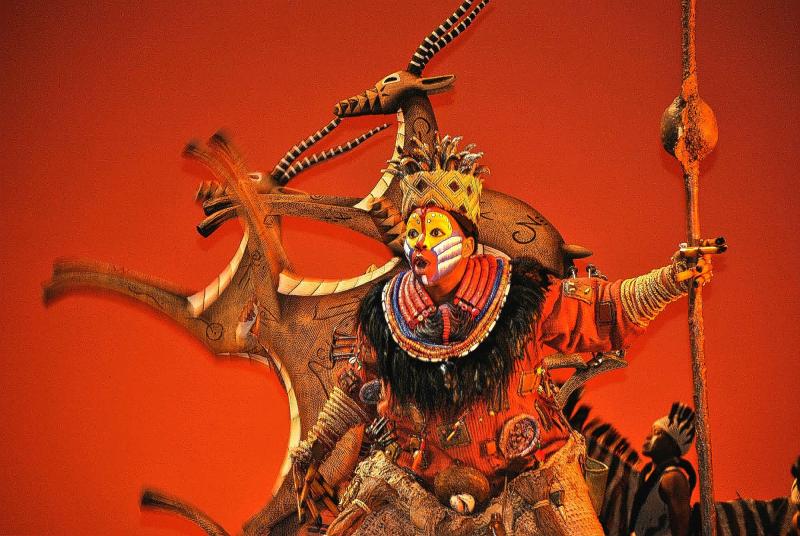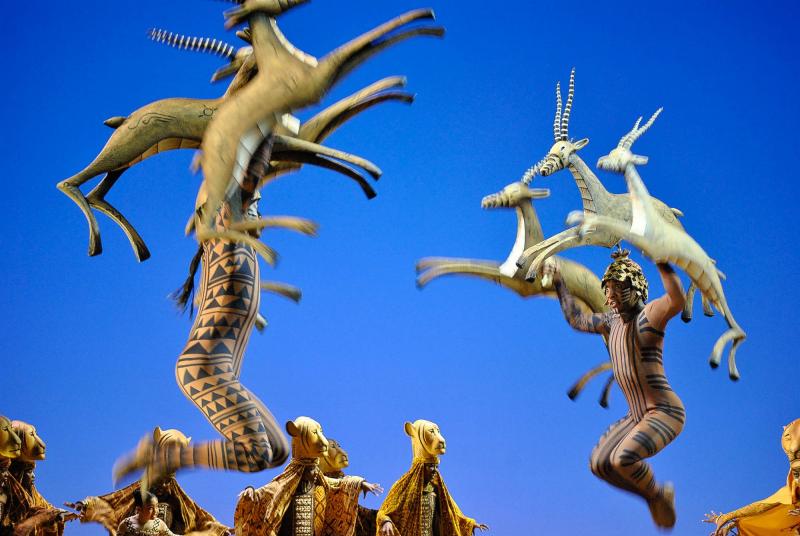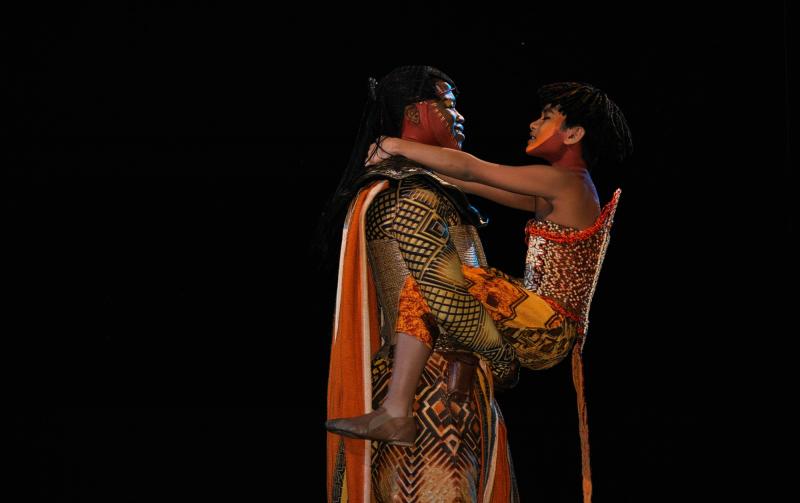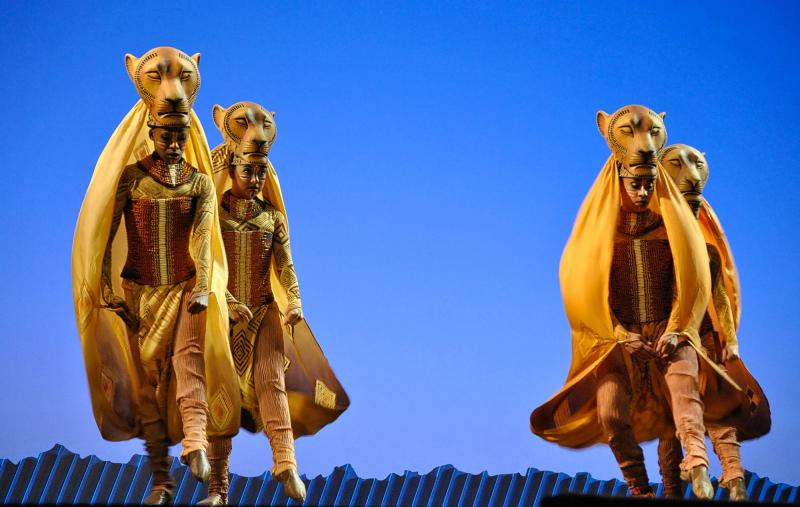Review: THE LION KING First International Touring Production Is Goosebump-Inducing Spectacle

Manila, Philippines--Philippine theater enthusiasts will surely take pride in the Manila kickoff of the first-ever international touring production of Disney's "The Lion King," hailed as "the world's #1 musical."
Not only it boasts a stellar roster of creative stalwarts, a revenue over $1 billion, an entitlement as Broadway's third longest-running musical, it also is a proud keeper of a bevy of Tonys (6 "gongs" in all) including Best Musical, Best Musical Direction, and Best Costume Design.
Truth be told, this Disney stage musical has sold over 14,000 tickets on its first day of priority booking in Manila, a new record. The local buzz generated by "The Lion King" is undeniably intriguing.
But, is there more to this musical than meets the eye? Does this daringly ambitious theatrical adaptation rise to the challenge of the ever-changing taste of modern theater audiences, and the discriminating Filipino fans in particular?
The star-studded premiere on March 28 at The Theatre at Solaire could very well hold the answer, the media hype on the sold-out advance tickets regardless.
Theme and Plot
Based on the 1994 Disney box-office hit, "The Lion King" chronicles the journey of Simba, a reckless but precocious cub who was forced to leave The Pridelands after the death of his father Mufasa, the king. Unknown to all, Simba was banished by the king's evil brother Scar, who orchestrated Mufasa's demise. Away from his kingdom, Simba grows into a brave lion, all ready to take back his kingdom, now ruled by his Uncle Scar. Against Scar's army of evil hyenas, Simba fights his final battle to earn his rightful place in The Pridelands and save his kingdom from famine and the enemy that threatens them.
The story centers on courage, loyalty, and love of home and family--values that many Filipinos can relate well to.
 A Cornucopia of Spectacle
A Cornucopia of Spectacle
The show opens with Rafiki, fabulously played by Ntsepa Pitjeng, proclaiming the "Circle of Life" in a gloriously choreographed gathering of African savannah beasts and birds surreptitiously popping up from all corners of the stage and auditorium. Only one minute into the show, the theatre is already roaring with collective gasps and applause.
The much-anticipated parade of puppetry and colorful costumes (you decide which is which) showcases director Julie Taymor's vision of a "double event," which successfully melds the actor and the animal into one singular unit without depriving the audience of seeing the actual mechanical process.
The final output of this intended audience-puppet interactive exchange is transcendental as it is transformational--thrilling beyond comprehension the kids in the audience, and awakening the kid in every adult present.
Yes, number after number, the applause came. The stampede scene in Act 1 and the "He Lives in You" reprise in Act 2 will surely leave you breathless--such ingenuity! Before the curtains finally came down, the audience was already on its feet cheering.
Taymor's 'Double Event'
The Lion King's "mane event" is its ground-breaking live puppetry where animals are anthropomorphized by their human puppeteers, sans the hand-manipulated strings. In this aspect, the human hand becomes the string itself, and the puppet's movement is driven by the actor's organic expression. On the other hand, the actors' faces provide the perfect complement to the masks, and the audience is treated to a human-object interaction without compromising relatability and believability.
 The producers' decision to harness the innovator-visionary in Taymor falls not on barren grounds--she has successfully torn the production away from the shadows of the movie version and the fangs of cynicism that hound any stage translation. The actors complement this directorial vision by showcasing their versatility on all fronts: acting, singing, dancing, and puppetry, of course.
The producers' decision to harness the innovator-visionary in Taymor falls not on barren grounds--she has successfully torn the production away from the shadows of the movie version and the fangs of cynicism that hound any stage translation. The actors complement this directorial vision by showcasing their versatility on all fronts: acting, singing, dancing, and puppetry, of course.
An Actor's Savannah
The challenges thrown at actors in this production are obviously from all directions; any inferior cast member would have been an easy prey for all forms of predatorial criticism. However dangerous the ambition of this production may have been, the ensemble gathered for this production proves that any uncharted terrain could be conquered given the production's steadfast wisdom and sharp vision. What could have been a dangerous savannah has now become an exciting artist playground.
Leading the pack of talented performers are Pitjeng (Rafiki), Mthokozisi Emkay Khanyile (Mufasa), Andre Jewson (Zazu), and Antony Lawrence (Scar). However, let me start this particular commentary not from the top of the billing chain, if you may.
The multicultural ensemble of singers and dancers is key to bringing the colorful and vibrant African culture to the very marrow of this production without the slightest hint of cultural appropriation. Their voices and movements combine to create a genuine ambiance of African sights and sounds that are, at the very least, goosebumps-inducing.
 Filipino child actors Gabriel Tiongson (Young Simba) and Felicity Kyle Napuli (Young Nala) are a joy to behold, both generously giving their sincere portrayals despite their very young age. Both Tiongson and Napuli exude so much honesty in their portrayals, it is tragic not to see them anymore in Act 2.
Filipino child actors Gabriel Tiongson (Young Simba) and Felicity Kyle Napuli (Young Nala) are a joy to behold, both generously giving their sincere portrayals despite their very young age. Both Tiongson and Napuli exude so much honesty in their portrayals, it is tragic not to see them anymore in Act 2.
Jamie McGregor (Timon) and Pierre van Heerden (Pumbaa)--the perennial partners in laugh-out-loud crime--provide much of the comic relief, shamelessly dishing out cross-musical references and a dose of Tagalog puns to unsuspecting Pinoys. Don't tell me you were not forewarned.
Andre Jewson's Zazu has got the bird of gab, ensuring that those familiar punchlines would sound as crisp and funny as they were in the movie, 24 years ago. It is evident in this production that these lines will continue to evolve. The "Singapore" reference, however, misses its comedic mark as the context of such is, to most, vague.
Pitjeng's Rafiki is the only character that wears no mask or headdress. This adds more texture to her solid portrayal, which is already bursting with impeccable comedic timing and vocal bravura. On the other hand, Khanyile's Mufasa is the perfect father to Tiongson's Young Simba--firm but compassionate, brave but gentle; while Lawrence's Scar is a delightful evil to behold, his performance effervesces with enviable presence, energy, and snarl.
 Noxolo Dlamini's Nala actually starts out shaky but she manages to get through the show-stopping "Shadowland" number unharmed. Her romantic counterpart Calvyn Grandling's Simba is a combination of physical and vocal power; however, there seems to be something lacking in their chemistry, which to Grandling's somewhat mechanical delivery of spoken lines may be attributed.
Noxolo Dlamini's Nala actually starts out shaky but she manages to get through the show-stopping "Shadowland" number unharmed. Her romantic counterpart Calvyn Grandling's Simba is a combination of physical and vocal power; however, there seems to be something lacking in their chemistry, which to Grandling's somewhat mechanical delivery of spoken lines may be attributed.
Arguably, the hyenas played by Candida Masoma (Shenzi), Bjorn Blignaut (Banzai), and Mark Tatham (Ed) are the stars of the show. Masoma, Blignaut, and Tatham played their roles to the hilt, all three in an enviable display of chemistry and comedic timing. Their deadpan humor will surely leave you in stitches, while their presence from Act 1 to Act 2 ensures you leave the theatre with cathartic bliss overload.
Book, Music and Lyrics
The book by Roger Allers and Irene Mecchi may have cut out the well-loved musical number "The Morning Report," but the additional songs "Shadowland" (Hans Zimmer, Mark Mancina) and "Endless Night" (Taymor, Lebo M, Zimmer, Jay Rifkin) provide a deeper look into the fears and longing of Nala and Simba whose exiles are the pivot to Simba's return. The narrative then becomes clearer and more deeply personal.
 Elton John's soundtrack for the movie (with lyrics by Tim Rice) won for him the Academy Award, while two of the featured songs, "Can You Feel the Love Tonight" and "Circle of Life" were both top-selling and award-winning. John and Rice's score has that universal appeal, and further collaboration with celebrated South African composer Lebo M (additional music and lyrics, vocal score) firmly grounds "The Lion King" in the African culture, making the stage version a more holistic experience.
Elton John's soundtrack for the movie (with lyrics by Tim Rice) won for him the Academy Award, while two of the featured songs, "Can You Feel the Love Tonight" and "Circle of Life" were both top-selling and award-winning. John and Rice's score has that universal appeal, and further collaboration with celebrated South African composer Lebo M (additional music and lyrics, vocal score) firmly grounds "The Lion King" in the African culture, making the stage version a more holistic experience.
Scenic Design, Lights, Costumes, and Choreography
Equally delightful is Richard Hudson 's scenic design that seems to have materialized from a Leo Lionni page. Donald Holder 's lighting design is a visual spectacle in itself, transforming the stage from a delightful savannah to a colorful sunset, from a dreary graveyard to a wonderful nightscape. Taymor 's costumes feature authentic African textures and patterns so adeptly designed to serve not merely as the actors' external garments but also as the organic extension of their characters, which then provides further texture and dimension to Garth Fagan 's outstanding choreography.
The Verdict: "The Lion King" is a goosebump-inducing spectacle that also appeals to the heart. A must-see!
Disney's "The Lion King" runs now through May 6, 2018 at The Theatre at Solaire in Paranaque City. Buy tickets from TicketWorld.com.ph.
Photos: Oliver Oliveros
Reader Reviews
Videos


